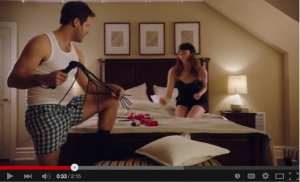When a Lover Avoids Intimacy or Wants to Control or Hurt You (or you them) on a Regular Basis, Look for Past Trauma
When the 50 Shades of Grey books became a phenomenon, I got the audio version, so I could listen while I was driving or doing the dishes. To be honest, I didn’t make it halfway through the first one – I feared if Anastasia said, “Oh my!” one more time, I was going to “toss my cookies” all over my car.
Thus, I preferred the movie. (I don’t think she said “Oh my!” even once.)
Let’s start this off with a few laughs. Here’s a 2-minute video parody on “50 Shades of Grey.”
Now, here’s my quickie review of the film that I shared with a colleague who asked me about it:
Not a great film, but a great conversation piece. Interesting power play (outside the “play” room), and lots to consider about how early childhood emotional wounding affects/distorts/clamps down people’s sex lives, even if the wounding was not specifically sexual. That’s what I typically see in my sexual healing work with clients.
Bottom line: Billionaire Christian Grey is a “control freak” (as Anastasia Steele put it) and terrified of intimacy (as I put it). It’s not surprising, as his history is revealed.
In the film, Anastasia was more often than not in the power position. Mainly because, in spite of Grey’s compelling looks, charm and wealth, coupled with her willingness to explore and push her comfort envelope, she ultimately stuck with what was right for her. Yay, Ana!!
Giving Voice to the Shadow
One important thing 50 Shades does is something that art — literature, television, film and so forth — often does, and that’s to voice something (often unspeakable) for us. It can give voice to darkness, our shadow side.
For example, in the 70’s one of the most popular TV shows was the sitcom, All In The Family. Archie Bunker, the father in this family, voiced all the bigotry against minorities and hippies and feminists – all the political incorrectness that many viewers were feeling but couldn’t say. They couldn’t voice it without guilt and shame or social recrimination. The Archie Bunker character did it for the culture.
In the same way, I think, 50 Shades of Grey voices some of what we would call “shadow” urges. When it stays in the fantasy realm, it’s a way to explore the shadow without having to do anything. However, even this can be very painful for some people, which I’ll discuss further below.
Another “shadow” urge, especially for powerful women and men, is to be submissive or have a “vacation” from sexual propriety. Allowing someone to dominant you in a role-play situation, temporarily frees you from taking responsibility for your actions or your pleasures.
I’ve had a couple of dominatrices as clients in my sexual healing practice. These are women whose own clients are powerful male executives longing to be released from responsibility for a short while by secretly hiring a woman to dominate them.
The Push-Pull for Intensity
Another thing I think is important to recognize is the increasing push-pull in our culture relative to intensity.
The lure of intensity is on a seesaw. People want intense experiences. Note that both violence and beauty in the media are increasing in intensity. And “The Red Room of Pain” in 50 Shades of Grey depicts a realm where sexual experience ride the edge of intensity or pain, the edge beyond which is it potentially unbearable. It’s very compelling for a lot of people, though often only in fantasy.
Yet, many are numbing out to every day life with anti-depressants. Ironically, dulling the pain also dulls the pleasure. Flip sides of the same coin. More on this at another time.
Different Ways it Affects People
Two years ago, when the books were all the rage, I was on a panel interviewed on the topic by Arielle Ford for her “The Art of Love” telesummit.
Before the interview I wrote to my subscribers asking for their feedback on the “50 Shades” books, and I received a lot of it. Their (or your) responses fell into three categories:
1. Inspired to try some new things with their partner (blindfolds, light bondage, spanking, and such), or even just discuss fantasies with more comfort
2. (From self-described strong, powerful women) Loved the inspiration for fantasies and arousal resulting from the idea of being dominated, so they could explore their submissive side (solo or with a partner)
3. Old wounds got triggered, sometimes about past relationships with someone who took bondage and dominance to an emotionally, and sometimes physically, damaging realm.
Let’s break this down, starting with number 1, above.
 1. As an example of this one, I’ll tell you about a woman (I’ll call her Barbara) I met at a workshop when the books were first the rage. She was married with four teenage children at home, and was co-owner of a very demanding fast-growing business. She bought 50 Shades, but had not read it. However, her husband had been lured into browsing.
1. As an example of this one, I’ll tell you about a woman (I’ll call her Barbara) I met at a workshop when the books were first the rage. She was married with four teenage children at home, and was co-owner of a very demanding fast-growing business. She bought 50 Shades, but had not read it. However, her husband had been lured into browsing.
While we were eating lunch outside on a deck overlooking the ocean, Barbara’s husband called her. He wanted her to know he was headed to the hardware store, had made plans to get the kids out of the house the first night she was home, and an adventurous evening would ensue. (Now, that guy understands female arousal!)
She was thrilled that he was putting the effort into creating some fun variety in their sex life and possibly exploring some edges together.
I think this has the potential for being the best possible outcome of the books and film – motivating couples to explore new things, discuss fantasies and broaden their intimacy by being vulnerable in a safe manner. It also has the potential for providing a safe place for a couple to explore their shadow sides together.
2. (May be combined with #1 above) Women who are strong and tend to draw on their masculine energy to be successful in the world often find that they want to let go into more of their deep feminine side in the bedroom, but they don’t know how to do this. The bedroom is where they most want a man to lead them or guide them.
Dominance and submission in Grey’s “Red Room of Pain” is a primal urge taken to the extreme (a politically incorrect extreme). And for some, even if they never play it out in reality, it opens up a very arousing fantasy realm.
3. For many, it (even hearing about the books) triggered past wounding from adult or childhood abuse. Several people wrote to tell me how they had been in a relationship and explored BDSM (Bondage & Discipline, Dominance & Submission, Sadism & Masochism), and it was really at the preference of their partner. Therefore, they had found themselves getting very wounded. They actually found that it became a real hurdle to them in their sex life later on.
One woman said it had some benefits in terms of intimacy with her partner, but then there was the dark side, because it created enough wounding that their relationship couldn’t overcome that.
Christian Grey Could Be My Client
Spoiler alert:
Christian Grey had been abused in early childhood (not clear if it was sexual). Later, he was repeatedly sexually molested as a teenager by his adopted mother’s friend.
I very often see with my clients that challenges with intimacy and sexual happiness stem from early experiences that, on the surface, don’t appear to be particularly traumatic.
Here’s the pattern I typically see:
1. We have an experience that is uncomfortable or thwarts what we want or denies our perception of the situation.
2. We then draw a conclusion (usually inaccurate).
3. We make a decision about how to move forward in life, and look for experience to confirm our conclusion until it becomes a belief, usually subconscious.
For example, during a sexual healing session, Susan tracked her problems with intimacy to an experience at age three, when she was at a family party. Her favorite uncle walked in, and she excitedly tried to tell him about something wonderful that has happened, but he picked up the phone to answer an important call. He told her to shut up, and then he yelled at a family member to get her out of the kitchen.
Her conclusion/belief: Her joy and natural self-expression is an unwelcome problem for others, especially men, and gets her banished from the party.
Her unconscious decision: If she wants to be loved, she needs to stifle herself; hold back her spontaneous joy and pleasure – and certainly don’t express it to a man.
You can’t establish deep intimacy if you can’t be vulnerable enough to express yourself freely with your partner.
This was the kind of everyday occurrence that happens in families everywhere. You can see how actual abuse could lead to not only fear of intimacy, but an extreme need for control, possibly sexual frigidity, impotence, or aberrant behavior. I have had several clients over the years who are or were sex workers (the professional dominatrices I mentioned above, who were my clients, were quite aware that their work in some way served their own healing).
I have not read the other two 50 Shades of Grey books, but I’m sure they will show up on the big screen. From what little I’ve heard, my guess is that they are about Christian Grey’s healing journey.
You can have your own healing journey. I work with clients for “Rapid Sexual Healing.”


